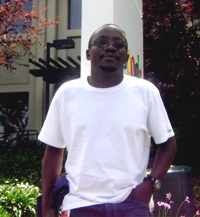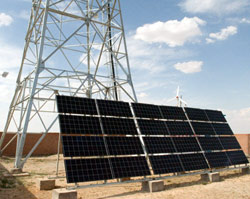 This guest post was written by Robert Ndlovu an ICT consultant based in San Jose, California, USA. It is the first in a series of posts he’s writing about rural telecommunication solutions. The second post can be found here. We’ll update this post with links to the rest or the posts once they’re posted in the next few days.
This guest post was written by Robert Ndlovu an ICT consultant based in San Jose, California, USA. It is the first in a series of posts he’s writing about rural telecommunication solutions. The second post can be found here. We’ll update this post with links to the rest or the posts once they’re posted in the next few days.
Background
Recently the Postal and Telecommunications Regulatory Authority of Zimbabwe (POTRAZ) made an announcement that it had committed US$24 million from the Universal Services Fund (USF) for implementing eight projects in the rural areas. No specifics as to which telecoms operators had been tasked to carry out the rural network outreach programs. Also no specific areas in the 8 provinces were made public by Eng. Charles Sibanda who made the announcements.
Studies that have been conducted worldwide have identified that telecommunications is an important tool for the economic development and self-sufficiency in any society. Indeed, mobile and internet penetration are now used as key economic indicators.
Despite these potential benefits, it is apparent that a range of problems need to be addressed before this opportunity can be realized. Most of these rural communities are geographically isolated and economically disadvantaged, and have generally not attracted the interest of commercial service providers.
The announcement by POTRAZ is good news – on paper at least. We all know the attitude of the present telcos; regardless of what they say in public, they have NO interest in extending their services to rural areas. I wonder what has changed this time around that will make the likes of Econet, NetOne, TelOne, Powertel, Telecel and others to suddenly develop a keen interest in deploying coverage in rural Zimbabwe. Maybe through the new entrants in mobile services like Africom and others, we may see something being done to bring the sense of a digital economies to rural areas.
This is my public request to POTRAZ & the Minister of ICT Nelson Chamisa under whose Ministry these projects will be rolled out:
“Could we please have a publication of, (1) which companies are receiving money from the Universal Services Fund and (2) which 8 areas have been ear-marked for rural network deployments? That way we will know who to hold accountable with public funds should the areas ear-marked for network coverage be still with NO coverage 3 years from today.”
Really no need to reference examples here where some A2 farmers received farming inputs from government, only to have the nation having to import grain, leaving us all wondering what happened to the farming inputs.
Ok, let’s move on with what could be done to bring ICT and telephony to Nkayi, Gokwe, Guruve, Chiadzwa and Wedza just to mention a few as an example.
Solar Powered Wireless for Rural Connectivity
In the game of chess there is what is called twin forking where you pin two strong pieces on the board by one move. This is what this article is about. Addressing Africa’s two hindrances to bridge the digital divide starts with addressing electricity supply and connectivity technologies – solar energy for power and wireless technology for connectivity.
Easier said than done I hear some of you say already. Yes, but NOT impossible. The solar cell, which can function on minimal natural light, enables a phone to be installed in remote areas where it is impractical to run power cables to the unit. If insufficient light is available the device can be backed up by a battery.
NetOne last year, started installing solar powered base stations to avert the ZESA power outages.
Solar Primer – Insolation
Solar panels convert photons of light into electrical current by a process known as the “photovoltaic effect”. This essentially means that the solar energy illuminating is causing electrons in a solar panel to become excited. These electrons are then directed into an electric current by a built-in electromagnetic field. Africa receives a lot of sunshine because most countries are not too far from the Equator. A standard way to measure the amount of sunshine received in an area is called – insolation. This is expressed as kilowatt hours per square meter per day. No rocket science involved here; southern Africa has higher insolation values than Canada!
Typical average annual insolation levels:
Central Australia = 5.89 kWh/m2/day – Very High
Bulawayo, Zimbabwe = 4.5 kWh/m2/day – High
Helsinki, Finland = 2.41 kWh/m2/day – Very Low
Solar equipment
 Deployment of these systems is not too complex if done by trained personal. Deployment involves system sizing, which basically includes estimating the power consumption by the system. Through the use of chargers, batteries are used to store electrical energy to power the system at night or during times when sunshine is at its lowest.
Deployment of these systems is not too complex if done by trained personal. Deployment involves system sizing, which basically includes estimating the power consumption by the system. Through the use of chargers, batteries are used to store electrical energy to power the system at night or during times when sunshine is at its lowest.
Most end user wireless equipment has pretty low power consumption levels but transmitters used by the service provider will need larger solar systems which means digging deeper into the pocket – one reason that scares most people way from deploying solar powered systems.
Wireless Primer
The term wireless is pretty broad in the true sense of the word. On the streets of Bulawayo or Harare this means a cellphone to the average citizen. Accurate in a sense. I am not offering a wireless tutorial here, but tech savvy readers must realize and appreciate that the bulk of the readers are not as tech savvy and as such a clearer explanation of what wireless technology is, will go a long way into unlocking what its full potential is.
Wireless technology revolves around the ability to send electromagnetic signals (radio waves) over the air using a transmitter with a receiver on the other end. A simple example would be the traditional Supersonic or WRS radio set where you tune into Radio Zimbabwe or National FM to listen to your favorite programs. TV also uses wireless technology. This is a one way radio system, where the user only receives and does not talk back.
The same technology is used for mobile phones with the only difference being that the user can talk back to the sender. The difference lies in what frequencies a network operator is allowed to transmit and receive signals. This is facilitated by use of base stations that mobile operators like Econet, NetOne or Telecel deploy.. The way the GSM operators operate would be the same way that you can wind your FM/AM dial to tune in to your favorite radio station at a technical and circuitry level.
Wireless technologies are characterized by their frequency range, their coverage area, signal loss, and transmission power. But suffice to say here that the different wireless technologies include, but are not limited to, GSM, Wi-Fi, WiMax, Satellite, Bluetooth etc.
The unique position with wireless technologies lies in their ability of not needing to use copper cables to send signals. But each country must regulate who uses which frequency otherwise there will be congestion caused by interference and it will be chaotic. Managing frequency spectrum is one of the roles of a telecoms regulator like POTRAZ in Zimbabwe. Otherwise if there was no control you would be able to hear some ZRP messages on your cellphone. (assuming your Nokia receiver can receive the signals of course).
The next installment will delve more into solar powered wireless access, the challenges and opportunities and some deployment scenarios.

2 comments
I’ll post the same information to my blog, thanks for ideas and great article.
Good article. Hope other stake holders will partner us look at the soft side of the digital divide (i.e. apps and skills). We (www.elearninginstitute.biz) are building on the skills side with our flagship course entitled “Using ICT4D to improve livelihoods”. We are about three/four months to Go-Live but we will be piloting the brick version of the course in about a month in collaboration with a Zim university that has a strong agriculture/environment/forestry mandate.